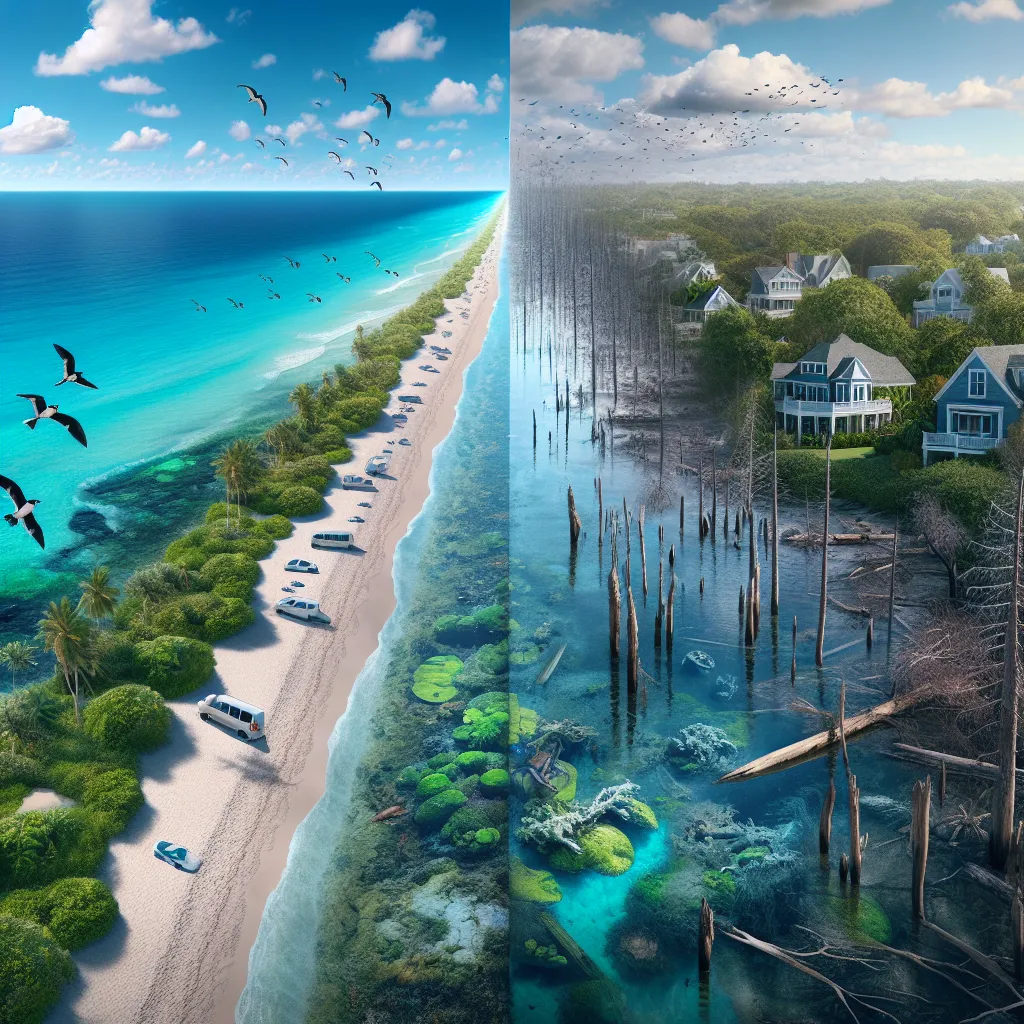Climate change and its impacts on coastal regions have become increasingly prevalent topics in IELTS Writing Task 2. This subject has appeared in various forms over the past few years, and its relevance is likely to grow as environmental concerns intensify globally. Let’s explore a sample question that reflects this trend and learn how to craft a compelling essay on this crucial issue.
Analyzing the Task
Consider the following IELTS Writing Task 2 question:
Climate change is having significant effects on coastal areas around the world. What are some of these effects, and what measures can be taken to address them?
Give reasons for your answer and include any relevant examples from your own knowledge or experience.
This question is a prime example of how the IELTS exam approaches the topic of climate change effects on coastal areas. It requires candidates to demonstrate their understanding of the issue and propose solutions, making it an excellent opportunity to showcase both knowledge and critical thinking skills.
Sample Essay
Here’s a model answer that addresses the question comprehensively:
Climate change is undeniably altering coastlines worldwide, presenting unprecedented challenges to both ecosystems and human settlements. This essay will examine the primary effects of this phenomenon on coastal regions and propose measures to mitigate its impact.
One of the most significant consequences of climate change on coastal areas is sea-level rise. As global temperatures increase, polar ice caps and glaciers melt at an accelerated rate, leading to a gradual but persistent increase in sea levels. This rise threatens to submerge low-lying coastal areas and islands, potentially displacing millions of people. For instance, the Maldives, an island nation in the Indian Ocean, is at risk of becoming uninhabitable within decades due to rising sea levels.
Another critical effect is the intensification of coastal erosion. Higher sea levels and more frequent storm surges associated with climate change exacerbate the natural erosion process, causing coastlines to recede at an alarming rate. This erosion not only results in the loss of valuable land but also jeopardizes coastal infrastructure and ecosystems. The eastern coast of England, for example, has experienced significant land loss due to accelerated erosion, forcing some communities to consider relocation.
Furthermore, climate change is altering marine ecosystems in coastal waters. Ocean acidification, caused by increased absorption of carbon dioxide, is damaging coral reefs and affecting the entire marine food chain. This has severe implications for coastal communities that rely on fishing and tourism for their livelihoods. The Great Barrier Reef in Australia has suffered multiple mass bleaching events in recent years, highlighting the vulnerability of these crucial ecosystems.
To address these challenges, a multi-faceted approach is necessary. Firstly, implementing robust coastal defense systems is crucial. This can include constructing sea walls, breakwaters, and flood barriers to protect vulnerable areas from rising seas and storm surges. The Netherlands, with its extensive system of dikes and flood control measures, provides a model for effective coastal protection.
Secondly, restoring and preserving natural coastal habitats is essential. Mangrove forests, salt marshes, and seagrass beds act as natural buffers against erosion and storm surges while also sequestering carbon. Initiatives to replant mangroves in countries like Indonesia have shown promising results in both coastal protection and carbon capture.
Lastly, there must be a concerted global effort to reduce greenhouse gas emissions. This involves transitioning to renewable energy sources, improving energy efficiency, and implementing stricter regulations on industrial emissions. International agreements like the Paris Accord provide a framework for collective action, but more ambitious targets and stricter adherence are necessary to truly mitigate the effects of climate change on coastal areas.
In conclusion, the impacts of climate change on coastal regions are diverse and far-reaching, from rising sea levels to ecosystem disruption. Addressing these challenges requires a combination of protective infrastructure, ecosystem restoration, and global commitment to reducing emissions. Only through such comprehensive measures can we hope to safeguard our coastal areas for future generations.
(Word count: 465)
 Climate change impacts on coastal areas
Climate change impacts on coastal areas
Writing Tips for This Topic
When tackling an IELTS Writing Task 2 essay on climate change effects on coastal areas, keep these points in mind:
-
Structure your essay clearly: Use a clear introduction, body paragraphs for each main point, and a conclusion.
-
Use specific examples: Incorporate real-world examples to support your arguments, as seen in the sample essay.
-
Balance causes and solutions: Ensure you address both the effects of climate change and potential measures to combat them.
-
Use appropriate linking words: Employ transitions to connect your ideas smoothly (e.g., “Furthermore,” “Moreover,” “In addition”).
-
Demonstrate knowledge of the topic: Show your understanding of climate change and its impacts through relevant vocabulary and concepts.
Key Vocabulary to Remember
Here are some essential terms related to this topic:
-
Sea-level rise (noun) /siː ˈlevl raɪz/ – The increase in the level of the world’s oceans due to global warming.
-
Coastal erosion (noun) /ˈkəʊstl ɪˈrəʊʒn/ – The wearing away of land and removal of beach or dune sediments by wave action, tidal currents, or other natural processes.
-
Ocean acidification (noun) /ˈəʊʃn əˌsɪdɪfɪˈkeɪʃn/ – The ongoing decrease in the pH of the Earth’s oceans, caused by the uptake of carbon dioxide from the atmosphere.
-
Storm surge (noun) /stɔːm sɜːdʒ/ – An abnormal rise of water generated by a storm, over and above the predicted astronomical tides.
-
Ecosystem (noun) /ˈiːkəʊˌsɪstəm/ – A biological community of interacting organisms and their physical environment.
-
Greenhouse gas emissions (noun) /ˈɡriːnhaʊs ɡæs ɪˈmɪʃnz/ – The release of gases that trap heat in the Earth’s atmosphere, contributing to global warming.
-
Mitigation (noun) /ˌmɪtɪˈɡeɪʃn/ – The action of reducing the severity, seriousness, or painfulness of something.
-
Coastal defense (noun) /ˈkəʊstl dɪˈfens/ – Structures or measures designed to protect the coastline from erosion and flooding.
Conclusion
Climate change effects on coastal areas is a topic that combines environmental science, geography, and social issues, making it a rich subject for IELTS Writing Task 2. By understanding the key concepts, using relevant vocabulary, and structuring your essay effectively, you can craft a compelling response to questions on this theme. Practice writing essays on related topics such as:
- The economic impact of climate change on coastal communities
- The role of international cooperation in protecting coastal ecosystems
- Balancing coastal development with environmental conservation
Remember, the key to success in IELTS Writing is practice and a solid understanding of the subject matter. Good luck with your preparation!
For more insights on related topics, check out our articles on the impact of climate change on global food systems and the impact of climate change on coastal erosion.


